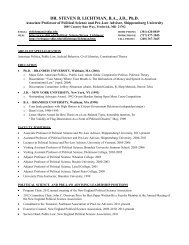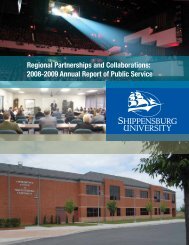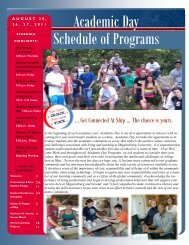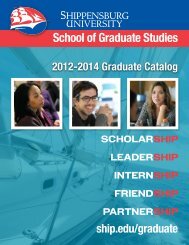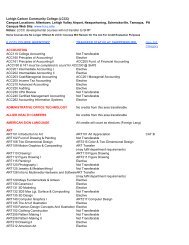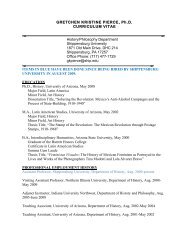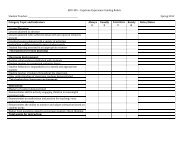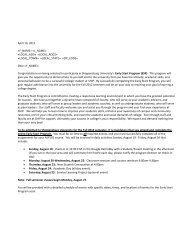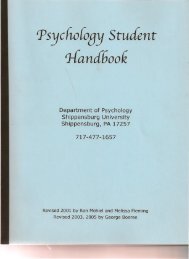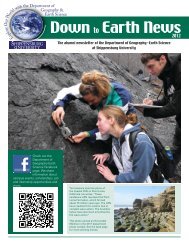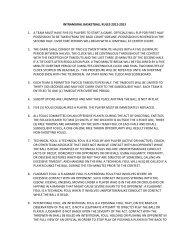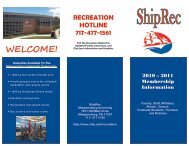Complete Issue - Shippensburg University
Complete Issue - Shippensburg University
Complete Issue - Shippensburg University
- No tags were found...
You also want an ePaper? Increase the reach of your titles
YUMPU automatically turns print PDFs into web optimized ePapers that Google loves.
8 PROTEUS: A Journal of Ideasthey add up to 26 percent of the market, accordingto Beverage Marketing, surpassing Coke and Pepsi’sbrands combined.Since most water brands are owned by largercompanies, it’s hard to get directly at the economics.But according to those inside the business, half theprice of a typical $1.29 bottle goes to the retailer. Asmuch as a third goes to the distributor and transport.Another 12 to 15 cents is the cost of the water itself,the bottle and the cap. That leaves roughly a dime ofprofit. On multipacks, that profit is more like two centsa bottle.As the abundance in the supermarket water aisleshows, that business is now trying to help us find newwaters to drink and new occasions for drinking them—trying to get more mouth share, as it were. Aquafinamarketing vice president Ahad Afridi says his team hasdone the research to understand what kind of waterdrinkers we are. They’ve found six types, includingthe “water pure-fectionist”; the “water explorer”; the“image seeker”; and the “struggler” (“they don’t reallylike water that much...these are the people who have acheeseburger with a diet soda”).It’s a startling level of thought and analysis—untilyou realize that within a decade, our consumption ofbottled water is expected to surpass soda. That kind ofmarket can’t be left to chance. Aquafina’s fine segmentationis all about the newest explosion of waters thataren’t really water—flavored waters, enhanced waters,colored waters, water drinks branded after everythingfrom Special K breakfast cereal to Tropicana juice.Afridi is a true believer. He talks about water as if itwere more than a drink, more than a product—as if itwere a character all its own, a superhero ready to takethe pure-fectionist, the water explorer, and the strugglerby the hand and carry them to new water adventures.“Water as a beverage has more right to extend andenter into more territories than any other beverage,”Afridi says. “Water has a right to travel where otherscan’t.”Uh, meaning what?“Water that’s got vitamins in it. Water that’s gotsome immunity-type benefit to it. Water that helpskeep skin younger. Water that gives you energy.”Water: It’s pure, it’s healthy, it’s perfect—and we’vemade it better. The future of water sounds distinctlyunlike water.The label on a bottle of Fiji Water says “from theislands of Fiji.” Journey to the source of that water,and you realize just how extraordinary that promise is.From New York, for instance, it is an eighteen-hourplane ride west and south (via Los Angeles) almost toAustralia, and then a four-hour drive along Fiji’s twolaneKing’s Highway.Every bottle of Fiji Water goes on its own version ofthis trip, in reverse, although by truck and ship. In fact,since the plastic for the bottles is shipped to Fiji first,the bottles’ journey is even longer. Half the wholesalecost of Fiji Water is transportation—which is to say, itcosts as much to ship Fiji Water across the oceans andtruck it to warehouses in the United States than it doesto extract the water and bottle it.That is not the only environmental cost embeddedin each bottle of Fiji Water. The Fiji Water plant isa state-of-the-art facility that runs 24 hours a day.That means it requires an uninterrupted supply ofelectricity—something the local utility structure cannotsupport. So the factory supplies its own electricity, withthree big generators running on diesel fuel. The watermay come from “one of the last pristine ecosystems onearth,” as some of the labels say, but out back of thebottling plant is a less pristine ecosystem veiled with adiesel haze.Each water bottler has its own version of thisoxymoron: that something as pure and clean as waterleaves a contrail.San Pellegrino’s one-liter glass bottles—so mucha part of the mystique of the water itself—weigh fivetimes what plastic bottles weigh, dramatically addingto freight costs and energy consumption. The bottlesare washed and rinsed, with mineral water, before beingfilled with sparkling Pellegrino—it uses up two litersof water to prepare the bottle for the liter we buy. Thebubbles in San Pellegrino come naturally from theground, as the label says, but not at the San Pellegrinosource. Pellegrino chooses its CO 2 carefully—it isextracted from supercarbonated volcanic spring watersin Tuscany, then trucked north and bubbled intoPellegrino.Poland Spring may not have any oceans to traverse,but it still must be trucked hundreds of miles fromMaine to markets and convenience stores across itsterritory in the Northeast—it is 312 miles from theHollis plant to midtown Manhattan. Our desire forPoland Spring has outgrown the springs at PolandSpring’s two Maine plants; the company runs a fleet of80 silver tanker trucks that continuously crisscross thestate of Maine, delivering water from other springs tokeep its bottling plants humming.In transportation terms, perhaps the waters with theleast environmental impact are Pepsi’s Aquafina andCoke’s Dasani. Both start with municipal water. Thatallows the companies to use dozens of bottling plantsacross the nation, reducing how far bottles must beshipped.Yet Coke and Pepsi add in a new step. They putthe local water through an energy-intensive reverseosmosisfiltration process more potent than that usedto turn seawater into drinking water. The water theyare purifying is ready to drink—they are re-cleaningperfectly clean tap water. They do it so marketing canbrag about the purity, and to provide consistency: Soa bottle of Aquafina in Austin and a bottle in Seattletaste the same, regardless of the municipal source.



